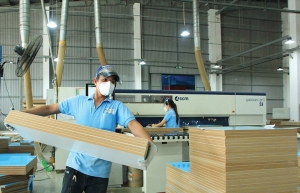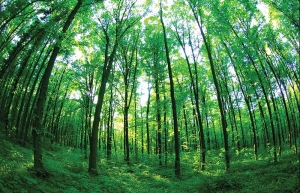Vietnam must confirm legit timber supply sources
As the new timber trade chain is gradually taking shape, what makes Forest Trends interested in Vietnam’s timber supply?
 |
| Dr. To Xuan Phuc, managing director of Forest Trends |
We advocate for sustainable forest governance. Sustainability here is not only the development of certified forest areas, but also the introduction of reasonable development policies, including social, environmental, and economic factors. This includes a policy to ensure the inclusion of millions of smallholder tree growers who play a vital role in producing plantation timber to market.
In Vietnam, businesses or actors participating in the supply chain have to comply with national laws concerning timber production and trade. By entering into the Voluntary Partnership Agreement with the EU and a Timber Agreement with the United States, the Vietnamese government has committed to excluding illegal timber from export and domestic supply chains. At present, the government is translating these commitments into domestic laws.
Compliance to timber legality and pursuing sustainability standards is important to conserve the environment while ensure the economic viability and social inclusion. Forest Trends is interested in promoting this.
Could you provide an example of this?
In Laos, Forest Trends is collaborating with some Vietnamese rubber companies investing in Laos and with the Lao Rubber Association. We have been supporting these companies in exploring the opportunity to obtain sustainably-certified rubber in the future. Pursuing sustainability requires these companies to look back their practices associated with land concession and land use undertaken in the past and to find a way to correct the practices that were not in line with government regulations and/or in conflict with local communities.
Through our collaboration with the Lao Rubber Association, we intend to derive insights from this process to feed into the policymaking process in Laos. We have been discussing policy frameworks based on experience in linking businesses and forest growers to create a source of certified quality timber materials. At the same time, we’re trying to apply those experiences to other investment models.
Would you say that different land and forestry institutions will create different challenges and advantages in sustainable development?
That is correct. Vietnam still has numerous state forest and rubber companies that are using a large track of land for the production of plantation timber. This land was given to them by the state. As land has become an important asset, access to land becomes a unique opportunity for these companies to generate revenue through tree and rubber production.
The land policy of Laos is somewhat different from that of Vietnam. Unlike in Vietnam where almost no foreign companies were given land, in Laos the government here granted land concessions to foreign companies, including Vietnamese ones, to produce timber and rubber.
Forest and rubber companies in Vietnam and in Laos can pursue sustainable production (for example FSC or PEFC). For these companies, it seems that carrying out sustainable production in Vietnam is easier than doing it in Laos and Cambodia as land concession processes in Laos and Cambodia were complex.
In Laos’ central region, Dak Lak Rubber Investment JSC (DRI), a subsidiary of Vietnam’s Dak Lak Rubber, is implementing a pilot model of growing nearly 10,000 hectares of certified rubber. Considering sustainability as important in seizing future market opportunity, DRI has made enormous efforts in pursuing FSC certification.
Engaging in this process, it has opened up space for DRI to look into all issues associated with land concessions occurred in the mid-2000s at the time the Lao government gave DRI the land. To address these issues, the company entered into dialogues with local communities and worked with local authorities.
Addressing issues associated with land concession is challenging. DRI said that it is willing to talk to the government to solve the issue, but it remains tricky as it is now under the jurisdiction of Laos’ National Assembly, not the local government as before.
Can you elaborate the shortcomings in Vietnam’s plantation forest supply chain?
There are two main concerns with the source of plantation timber being harvested and put into the supply chain. Firstly, the legality of the timber source needs to be verified. Secondly, the activities along supply chains need to be in compliance to the government regulations and to be traceable to ensure legality compliance.
Currently, some actors engaged in the middle of the chains do not strictly comply with legality requirements concerning timber legality, tax, and fee regulations, and reporting procedures. Part of the reasons is that the existing requirements are far from reality. Part of that is limited implementation by competent authorities.
The verification of wood origin for plantation timber is relatively simple. At the stage of harvesting, smallholder tree growers are responsible for making harvest records and declarations, including information on the location, land use rights, and land allocation. or lease. Photocopies of these documentations will be passed on to the next parties in the supply chain.
However, in practice, many problems exist. Many households have been allocated forest land for many years but, but have not been granted a certificate of land use right. Information from businesses collaborating with smallholders showed that only about 40 per cent of affiliated households have been granted this. This number may not fully reflect the current situation of issuance across the country. A lack of certification means that local households do not have legal evidence to prove they are the legal owner of the land.
In addition, verifying the legality of transactions in the supply chain is facing many difficulties, or is even in some cases impossible. The longer the supply chain, the more complicated the identification, and vice versa.
Currently, the supply chain of plantation timber in the southeast and central coast regions goes through 2-3 intermediate stages, as opposed to 4-5 stages in the northern mountainous region.
The timber trade supply chain is becoming more sustainable, but Vietnam’s supply chain remains fragmented and complex. Most enterprises participating in the export market do not have their own raw material areas. They collect raw materials mainly through civil relations, and there is no obligation on responsibility.
Meanwhile, international environmental and social organisations are closely monitoring supply chains, putting pressure on the governments of large timber and forest product importers, such as the US, about whether Vietnam must truly make commitments.
Vietnam is thus required to ensure the legality of timber, and supply chains are transparent and traceable. However, without a proper monitoring mechanism in place and noncompliance to existing regulation is still high, this remains a complicated task.
 | Fresh collaborations emerging in wood and timber industry Growth in Vietnam’s wood and timber industry is under threat of stagnation, but the establishment of inter-regional timber centre could help coordinate input supply and diverse order fulfilment. |
 | Competition tightens up for Vietnamese timber sector After related US delegations held talks with Vietnam’s Ministry of Industry and Trade on trade issues last week, it has become apparent that Vietnam’s wood and timber industry will need to up its game to hold and eventually increase its market share in the United States. |
What the stars mean:
★ Poor ★ ★ Promising ★★★ Good ★★★★ Very good ★★★★★ Exceptional
Related Contents
Latest News
More News
- Businesses ramp up production as year-end orders surge (December 30, 2025 | 10:05)
- Vietjet chairwoman awarded Labour Hero title (December 29, 2025 | 13:06)
- How to unlock ESG value through green innovation (December 29, 2025 | 10:03)
- AI reshapes media and advertising industry (December 29, 2025 | 08:33)
- FPT and GELEX sign deal to develop blockchain tech for global markets (December 29, 2025 | 08:29)
- Vietnam’s GDP forecast to grow by 9 per cent in 2026 (December 29, 2025 | 08:29)
- Women entrepreneurs are key to Vietnam’s economic growth (December 29, 2025 | 08:00)
- Vietnam's top 500 value-creating enterprises announced (December 27, 2025 | 08:00)
- The PAN Group shaping a better future with ESG strategy (December 26, 2025 | 09:00)
- Masan Consumer officially lists on HSX, marking the next phase of value creation (December 25, 2025 | 13:20)

 Tag:
Tag:





















 Mobile Version
Mobile Version